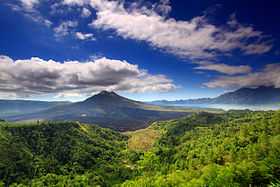Mount Batur
| Mount Batur | |
|---|---|
 Mount batur and lake | |
| Elevation | 1,717 m (5,633 ft) |
| Listing | Spesial Ribu |
| Location | |
 Mount Batur Bali | |
| Location | Bangli Regency, Bali, Indonesia |
| Coordinates | 8°14′31.2″S 115°22′30″E / 8.242000°S 115.37500°ECoordinates: 8°14′31.2″S 115°22′30″E / 8.242000°S 115.37500°E |
| Geology | |
| Type | Volcanic caldera |
| Last eruption | 1999 to 2000 |
Mount Batur (Gunung Batur) is an active volcano located at the center of two concentric calderas north west of Mount Agung, Bali, Indonesia. The south east side of the larger 10×13 km caldera contains a caldera lake. The inner 7.5-kilometer-wide caldera, which was formed during emplacement of the Bali (or Ubud) ignimbrite, has been dated at about 23,670 and 28,500 years ago [1]
The southeast wall of the inner caldera lies beneath Lake Batur; Batur cone has been constructed within the inner caldera to a height above the outer caldera rim. The Batur stratovolcano has produced vents over much of the inner caldera, but a NE-SW fissure system has localized the Batur I, II, and III craters along the summit ridge. Historical eruptions have been characterized by mild-to-moderate explosive activity sometimes accompanied by lava emission. Basaltic lava flows from both summit and flank vents have reached the caldera floor and the shores of Lake Batur in historical time. The caldera contains an active, 700-metre-tall stratovolcano rising above the surface of Lake Batur. The first historically documented eruption of Batur was in 1804, and it has been frequently active since then. The substantial lava field from the 1968 eruption is visible today when viewed from Kintamani, a town that stradles the southwest ridge of the greater caldera.
The caldera is populated and includes the four main villages of Kedisan, Songan, Trunyan and Toya Bungkah. The locals largely rely on agriculture for income but tourism has become increasingly popular due to the relatively straightforward trek to the summit of the central crater.[2]
The lake, Danau Batur, is the largest crater lake on the island of Bali and is a good source of fish.
On September 20, 2012 UNESCO has made Mount Batur Caldera a part of the Global Geopark Network.[3]
Sedimentation
Heavy sedimentation in Mount Batur Caldera makes water level increase and floods some low bank. A feasibility study is still running, heavy equipments will move muds from the lake and bury the low land around the lake, reboitation is also done to control sedimentation.[4]
See also
| Wikimedia Commons has media related to Mount Batur. |
References
- ↑ (Wheller 1986, Sutawidjaja et al. 1992).
- ↑ Langston-Able, Nick (2007). Playing with Fire: Adventures in Indonesia. Freakash. pp. 85–98. ISBN 978-0-9553403-4-5.
- ↑ "Kaldera Gunung Batur Sebagai Taman Bumi Global". September 30, 2012.
- ↑ 13:46:48 "Lumpur Danau Batur Bakal Disedot". Retrieved June 15, 2014.
External links
- "Batur". Global Volcanism Program. Smithsonian Institution.
-
 Kintamani travel guide from Wikivoyage
Kintamani travel guide from Wikivoyage